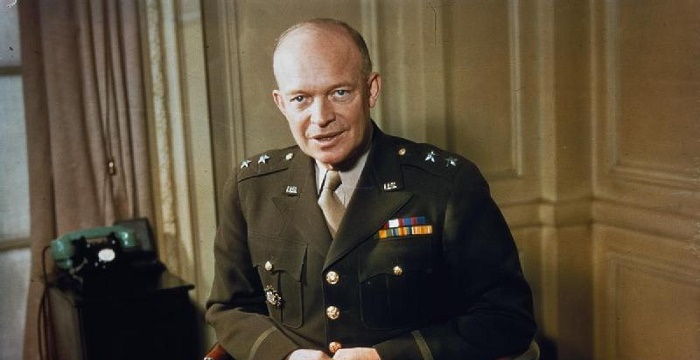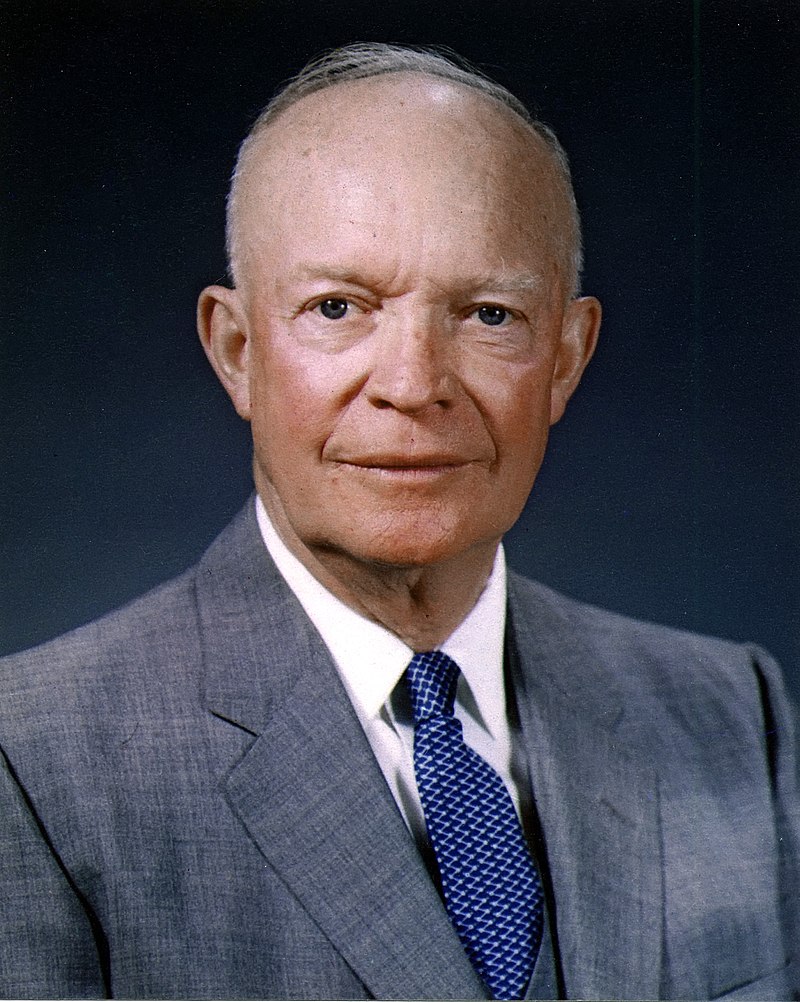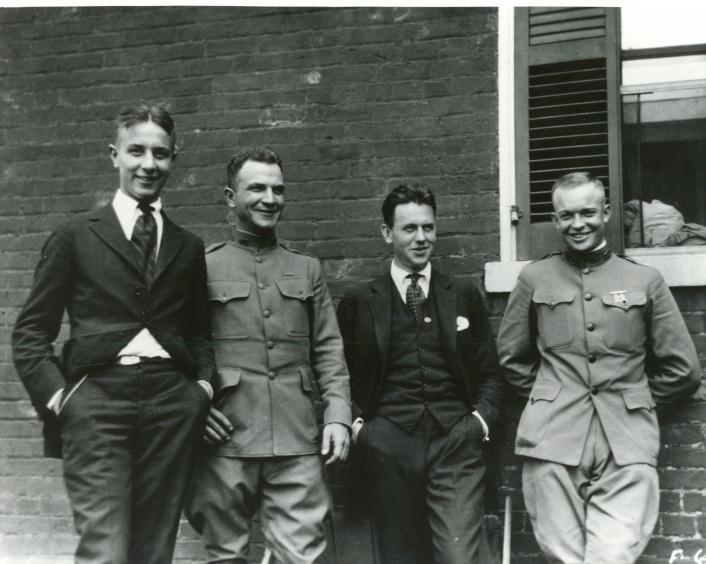On October 14, 1890, David and Ida gave birth to Dwight David Eisenhower in Denison, Texas. He was the third of seven sons. The family relocated to Abilene, Kansas, shortly after his birth. Eisenhower grew up in a poor household and discovered the importance of hard work by selling produce and working at a creamery, a spot where milk products such as butter and cheese are made or sold.
When Eisenhower was four years old, his 10-month-old brother Paul died of diphtheria in Abilene. Despite the loss, he had a peaceful upbringing in Abilene, which he will remember for the rest of his life. He grew up in the town and later graduated from Abilene High School in 1909. Despite being an ordinary pupil, Dwight Eisenhower loved history. Military personalities such as George Washington and Hannibal were among his heroes. He excelled in athletics and enjoyed his days as a baseball and football player at Abilene High School.
After graduating, he helped send his brother to college for two years. Dwight Eisenhower took and passed the United States Naval Academy entrance exam in 1911 but was denied entry due to his age. With Senator Joseph L. Bristow’s help, Eisenhower was assigned to the United States Military Academy in West Point, New York, in 1911, which he could attend for free. Although his parents were pacifists, they accepted his decision because it would provide him with a decent education. Dwight Eisenhower was a sensation on the football field once more before a string of knee injuries caused him to retire. Eisenhower was commissioned as a second lieutenant after graduating from West Point in 1915.
Dwight Eisenhower was stationed in Texas after graduation, where he met and began dating Mamie Geneva Doud, an 18-year-old from Denver, Colorado. On July 1, 1916, the pair married after nine months of dating. On his wedding day, Eisenhower was promoted to the first lieutenant.
Eisenhower and Mamie traveled from post to post across Texas, Georgia, Maryland, Pennsylvania, and New Jersey during the first five years of his military service. Mamie gave birth to the couple’s first child, Doud Dwight, in 1917. In the same year, the United States enlisted in World War I. Eisenhower had intended to be commissioned overseas, but he was later sent to Camp Colt in Gettysburg, Pennsylvania, to operate a tank training center. Eisenhower continued to climb through the ranks during the war and afterward. Since volunteering for the Tank Corps in the War Department’s first transcontinental motor convoy the previous year, he was promoted to general by 1920.
John Sheldon Doud, Mamie’s second son, was born in 1922. Dwight Eisenhower became General Fox Conner’s executive officer in the Panama Canal Region that year. Eisenhower was admitted into the Army’s elite training school, the Command and General Staff School at Ft. Leavenworth, Kansas, in 1924, at Conner’s urging. He graduated first in his two hundred forty-five class and was known for his military prowess in 1926.
Throughout his early Army years, he excelled in staff duties, serving under Generals John J. Pershing, Douglas MacArthur, and Walter Krueger. Back then, the Chief of Staff of the United States Army was General Douglas MacArthur, who preferred Eisenhower as an aide. When MacArthur’s tenure ended in 1935, Eisenhower went to the Philippines to act as a military adviser to the Philippine government. As Eisenhower was promoted to lieutenant colonel in 1936, he started to argue with MacArthur on military and philosophical matters. The claims caused Eisenhower to return to Washington in 1939 to assume a series of staff posts, igniting a schism that would last the rest of their lives. In June 1941, he was appointed chief of staff to 3rd Army commander Lieutenant General Walter Krueger, and in September of that year, he was promoted to brigadier general.
General George C. Marshall summoned him to Washington after the attack on Pearl Harbor for a war planning assignment. Dwight Eisenhower led the Allied Forces landed in North Africa in November 1942 and was Supreme Commander of the troops assaulting France on D-Day in 1944.
He could have profound disagreements with generals and leaders, such as Winston Churchill, without jeopardizing their coalition. The D-Day invasion was a success, but Berlin’s advance was more challenging and expensive than anyone had expected. Eisenhower was often mindful of the emotional expense involved and his duties to particular troops, meeting soldiers’ units daily.
Eisenhower was in command of the Allied parts of occupied Germany after the German surrender. He uncovered evidence of Nazi leaders committing crimes against humanity while also allowing more humanitarian assistance to reach German civilians in need.
He was initially optimistic that the United States could sustain good ties with the Soviet Union in the wake of WWII. However, by mid-1947, relations between the East and the West had risen, and Eisenhower had come to support Soviet containment policies.
After World War I, he became President of Columbia University and then took leave in 1951 to take charge of the new NATO forces that were being organized. Republican emissaries visited his headquarters outside Paris in 1952 and urged him to run for President.
He attempted to alleviate the tensions of the Cold War by negotiating from a position of military power. The declaration of a ceasefire in 1953 brought an armed truce to South Korea’s border. In the same year, Stalin died, causing a change in ties with Russia.
The new Russian leaders agreed to a peace settlement that made Austria obsolete. Both Russia and the United States had produced hydrogen bombs in the meantime. With the prospect of such disruptive power hovering over the world, Eisenhower held a summit in Geneva in July 1955 with the British, French, and Russian governments’ representatives.
The President suggested that the US and Russia share blueprints for each other’s military infrastructure and “provide aerial photography facilities to the other world within our countries.” The Russians were silent in response to the suggestion but were so pleasant during the meetings that tensions dissipated.
In 1953, he negotiated a truce in the Korean War, one of his most significant accomplishments. Eisenhower invented the word “domino theory” in 1954, meaning that it would rapidly spread across the region if Communists seized influence in one area. This theory was crucial because the CIA became heavily interested in planning foreign coups and destabilizing Communist and left-leaning regimes during this period. This included returning the Shah of Iran to power and planning the Bay of Pigs invasion of Cuba, which John F. Kennedy was tasked with carrying out.
In September 1955, Dwight Eisenhower suffered a heart attack in Denver, Colorado. Eisenhower was released from the hospital after seven weeks, and doctors confirmed his recovery in February 1956. He was re-elected in November for a second time.
In 1961, he returned to his farm in Gettysburg, Pennsylvania, after leaving office. He and his wife, Mamie, remained in Gettysburg until his death on March 28, 1969, from heart disease. Eisenhower was buried at the Eisenhower Presidential Library in Abilene, Kansas, after funeral services in Washington.
You can also read about some of the most famous fashion trends started by the military here.
Related Posts
Presidency and Policies of Dwight Eisenhower
Dwight Eisenhower’s Personality
Dwight Eisenhower’s First Lady
Dwight Eisenhower’s Children and Descendants
Childhood and Career of Dwight Eisenhower



